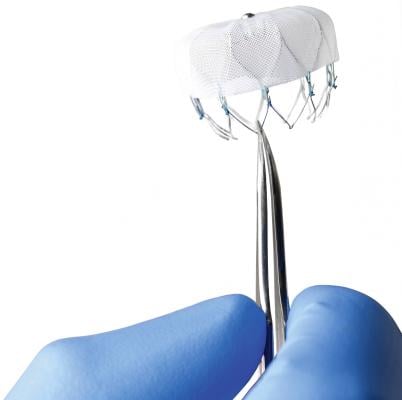
May 30, 2017 — Data was positive for safety and efficacy rates of the Watchman Left Atrial Appendage Closure (LAAC) Device from the EWOLUTION registry presented during a late-breaking clinical trial session at Heart Rhythm 2017, the Heart Rhythm Society's 38th Annual Scientific Sessions. Data confirmed that the Boston Scientific Watchman device had a high implant success rate and was effective in stroke reduction for patients with non-valvular atrial fibrillation (AF), including those patients deemed unsuitable for oral anticoagulation.
The prospective, single-arm, multicenter EWOLUTION registry evaluated 1,025 patients with non-valvular AF who have a high risk for stroke and systemic embolism. At one year post implantation of the device, the results demonstrated an 84 percent reduction in the annual stroke rate (1.1 vs. 7.2/100 pt-years) as compared to predicted rates of untreated patients with similar risk profile and a reduction of 48 percent in the annual rate of major bleeding (2.6 vs. 5/100 pt-years) as compared to predicted rates for patients treated with warfarin. CHA2DS2 VASc and HAS-BLED scores have been validated to predict annual rates of ischemic stroke and bleeding, respectively. In order to provide context for the results given the absence of a control group, analyses were performed to compare EWOLUTION event rates to these historical rates for patients of a similar risk profile, Boston Scientific said.
"This impressively low ischemic stroke rate favors left atrial appendage closure as an important therapy for patients ineligible for long-term oral anticoagulation," said Lucas V.A. Boersma, M.D., Ph.D., study principal investigator and electrophysiologist at St. Antonius Hospital, the Netherlands. "The results further validate the utility of the Watchman device as an excellent alternative to anticoagulant therapy and its related bleeding risks for patients with non-valvular AF."
In the study, patients were enrolled at 47 centers throughout Europe, Russia and the Middle East. More than 70 percent of the patients were deemed unsuitable for short or long-term anticoagulation at the time of Watchman implantation. Transient ischemic attacks, ischemic stroke, vascular disease and a history of major bleeding were present in approximately half of the patients.
"We are pleased to see that these 'real-world' results reinforce the positive outcomes observed in our clinical trial program, despite the registry patients being older and sicker than those enrolled in our previous trials," said Kenneth Stein, M.D., senior vice president and chief medical officer, rhythm management and global health policy, Boston Scientific.
The Watchman device was CE-marked in 2005 to prevent thrombus embolization from the left atrial appendage and reduce the risk of life-threatening bleeding events in patients with non-valvular AF who are eligible for anticoagulation therapy, and in 2012 the CE mark indication was expanded to include those who have a contraindication to anticoagulation therapy.
In 2015, the device received FDA approval for patients with non-valvular AF who are at high stroke risk, suitable for warfarin and are seeking an alternative to long-term warfarin therapy. The Centers for Medicare and Medicaid Services (CMS) began covering percutaneous LAAC therapy for Medicare beneficiaries in February 2016 when patients meet the specific criteria outlined in the agency's final National Coverage Determination (NCD).
For more information: www.watchman.com


 June 16, 2025
June 16, 2025 








